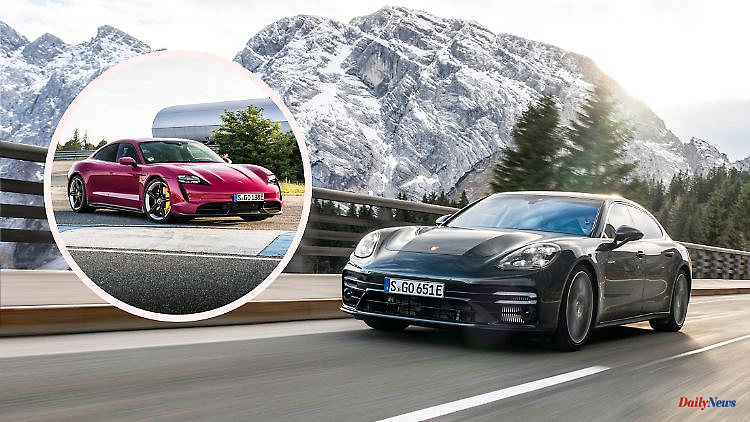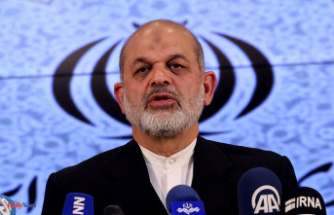Can emotional products from a brand like Porsche score with electric drives? After all, engine sound is part of the DNA here. Nevertheless, Porsche wants to go electric. So skimmed milk instead of full fat in the future? ntv.de compares Taycan Turbo S and Panamera Turbo S E-Hybrid.
This time ntv.de has two very hot irons in the fire. After all, it's about nothing less than the strongest and longest Porsche. And neither one nor the other listens to the designation 911. Because the 911 has so far stopped at 700 hp. And its length is a compact 4.54 meters - just a sports car. Now, for a change, it's about two seasoned luxury limousines. And since these come from Porsche, it definitely gets emotional - even with four doors.
So bring on the Porsche Taycan Turbo S. Its ecologically correct 761 hp certainly don't feel like skimmed milk. But because various state institutions no longer find the device quite so ecological, the subsidy for the purchase is sometimes dropped. The 189,668 euros (at least) have to be covered by the interests alone - only half the rate applies to the company car tax, which is based on half the gross list price.
Then as an alternative: the top model Panamera with the name Turbo S E-Hybrid. As an executive, the sedan is a respectable 5.20 meters long and offers rear-seat equipment including individual seats and small tables for working on the go. So that there are no misunderstandings - the luxury liner is also available as a pure combustion engine, but that would not be the top model. And with the plug-in hybrid, the customer at least has the option of driving purely electrically, but without having to do without the beloved, rumbling eight-cylinder.
The range issue should not be raised here to the decisive purchase argument. It is true that the range of the combustion engine is significantly higher than that of the Taycan with a maximum net battery capacity of 84 kWh - but the fast-charging network, at least in Germany, Austria, Switzerland and the Benelux countries, is so dense that comfortable long-distance travel is also possible with the Taycan. And after all, the corresponding chargers pump the electricity into the large battery with a peak output of 270 kilowatts - this means that a 5 to 80 percent battery charge level can be achieved in less than 25 minutes. Under optimal conditions, of course.
The tank of the Panamera holds around 80 liters, the consumption of which in hybrid operation with a moderate driving style levels off somewhere between just as moderate ten and eleven liters - gives a range of easily 700 kilometers. The manufacturer puts the range of the Stromer at a maximum of 573 kilometers when driving in the city, where electric cars work most efficiently. The combustion engine, on the other hand, is particularly efficient on the motorway around the recommended speed.
The purely electric range of the Panamera is around 50 kilometers, which, depending on the individual charging situation, makes it possible to drive for quite a long time without a combustion engine - and above all also guarantees the reduced company car tax (calculation basis only half of the gross list price).
On the other hand, you have to admit that the eight-cylinder is the unbeatable selling point for the Panamera Turbo S E-Hybrid if you don't want to do without the melodious four-liter turbo petrol engine. And a whole lot of financially powerful customers should even accept that the large Panamera accelerates a bit slower than the Taycan. That's clear, because with its system performance of 700 horses it has to move a weighty 2.5 tons, while the Taycan "only" has to push 2.3 tons - but in return leaves 761 hp on all four wheels.
But the complaining level is quite high, because the Panamera peppers its passengers with quite a bit of force in the lush leather upholstery. Within 11.2 seconds, 200 km/h should be reached from a standing start, which well-known super athletes can hardly do faster. However, the people from Zuffenhausen give their Taycan Turbo S only 9.6 to 200 km/h - and the value is credible, even confirmed by the relevant specialist magazines. But while the Panamera easily exceeds the 300 km/h threshold, the Taycan slows down at 260.
The Taycan proves that brute electric cars in particular can be fun with its incomparable initial acceleration. A full load from a standing start makes it so pushy that, as a precaution, you should only indulge in this pleasure if your stomach is stable enough. The paper warns of the specified 2.8 seconds - but the reality is more impressive.
The combustion engine does not push weakly (3.3 seconds to 100 things), but the hybrid drive train of the Panamera is complex. In it, the 571 hp eight-cylinder and the 136 hp potent electric motor have to arrange themselves together and the ensemble is moderated by colleague gearbox, his character eight-speed double coupler. However, the Taycan also allows itself a very short breather, namely when the transmission changes gear - the Porsche Taycan is one of the few electric models with an automatic two-speed transmission.
Which drive is more likely to be chosen by the customer is likely to be of a purely emotional nature. Both are incredibly fast, but the Stromer lacks the classic sound component, even though the Taycan by no means sounds like nothing. Here, too, sound designers were at work and created characteristic acoustics through the targeted use of resonances. But that's a long way from the sonorous V8 carpet of the Panamera. And because the cast-iron ones at Porsche know that too, they give the customer the choice.
Oh, and before the drive chapter ends, which is the main point here, we still need to take a look at the sedan skills of the two four-door top models.
Maximum wheelbase and thus maximum rear orientation is currently only possible with the Panamera (3.10 meters). The wheelbase of the luxury liner is 20 centimeters longer than the Taycan in the long Executive version. And apart from the stately space in the second row of the Panamera, you can also let yourself be kneaded in the armchairs and work on the optional folding tables (1990 euros net) when someone else is driving.
Not that the Panamera Turbo S E-Hybrid Executive, which starts at 211,905 euros net, is not a sufficiently active driver's car. Features such as standard adaptively controlled air suspension, rear axle steering and roll compensation work hard to make the 1.93 meter wide heavyweight Panamera appear agile. Works pretty well too. However, the bassy, rumbling tourer can also cruise comfortably and smooth out bad slopes effectively.
Just like the Taycan, whose lateral dynamics aren't bad either. With seven minutes and 33 seconds on the Nordschleife, it should be one of the fastest electric racers on the market if you disregard the extreme versions with over 2000 hp such as the Lotus Evija or Rimac. Seen in this light, the Taycan might be tempting after all. But it just doesn't sound good and it's not so luxurious to sit in the back. Maybe you just need both.












